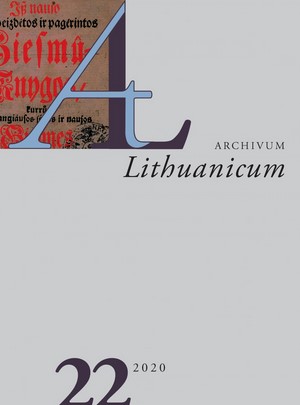SIMONO DAUKANTO BUDĄ SENOWĘS-LËTUWIÛ KALNIENÛ ĨR ƵÁMAJTIÛ (1845) ŠALTINIAI
SOURCES OF SIMONAS DAUKANTAS'S BUDĄ SENOWĘS-LËTUWIÛ KALNIENÛ ĨR ƵÁMAJTIÛ (1845)
Author(s): Roma BončkutëSubject(s): Review, Lithuanian Literature, 19th Century
Published by: Lietuvių Kalbos Institutas
Keywords: Simonas Daukantas; 1845; The Character of the Lithuanian Highlanders and Samogitians of the Old Times;
Summary/Abstract: The article investigates Simonas Daukantas’s (1793–1864) BUDĄ Senowęs-Lëtuwiû Kalnienû ĩr Ƶámajtiû (The Character of the Lithuanian Highlanders and Samogitians of the Old Times, 1845; hereafter Bd) with regards to genre, origin of the title, and the dominant German sources of the work. It claims that Daukantas conceived Bd because he understood that the future of Lithuania is closely related to its past. A single, united version of Lithuanian history, accepted by the whole nation, was necessary for the development of Lithuanian national identity and collective feeling. The history, which up until then had not been published in Lithuanian, could have helped to create the contours of a new society by presenting the paradigmatic events of the past. The collective awareness of the difference between the present and the past (and future) should have given the Lithuanian community an incentive to move forward. Daukantas wrote Bd quickly, between 1842 and May 28, 1844, because he drew on his previous work ISTORYJE ƵEMAYTYSZKA (History of the Lithuanian Lowlands, ~1831–1834; IƵ). Based on the findings of previous researchers of Daukantas’s works, after studying the dominant sources of Bd and examining their nature, this article comes to the conclusion that the work has features of both cultural history and regional historiography. The graphically highlighted form of the word “BUDĄ” used in the work’s title should be considered the author’s code. Daukantas, influenced by the newest culturological research and comparative linguistics of the 18th–19th centuries, propagated that Lithuanians originate from India and, like many others, found evidence of this in the Lithuanian language and culture. He considered the Budini (Greek Βουδίνοι), who are associated with the followers of Buddha, to be Lithuanian ancestors. He found proof of this claim in the language and chose the word “būdas” (character), which evokes aforementioned associations, to express the idea of the work.
Journal: Archivum Lithuanicum
- Issue Year: 2020
- Issue No: 22
- Page Range: 217-248
- Page Count: 32
- Language: Lithuanian

